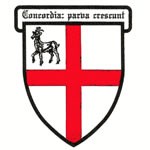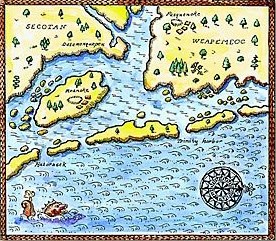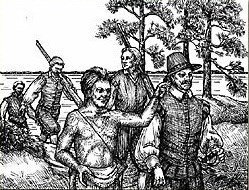

Vicki Wallace The ships sailed south to the Canary Islands and from there westward to the West Indies. Off Portugal the ships ran into bad weather. One of the pinnaces swamped and sank, and the rest of the fleet was scattered. Alone, the Tyger sailed on to the proposed rendezvous point near Puerto Rico, then a possession of Spain. There the English erected a temporary fortification for protection while they built a new pinnace. A week later they were alarmed by the appearance of the masts of a ship. They were relieved when the Elizabeth, separated from them a month earlier and 3,000 miles away, came into sight. With delays caused by the capture of a Spanish ship, the need to gather salt, and the purchase of supplies, the English finally arrived off Cape Fear on 23 June 1585. The next day they anchored and fished in the vicinity of present-day Beaufort Inlet. And finally on 26 June they reached Wococon on the Outer Banks. (It may or may not have been the present-day Ocracoke Inlet: inlets in this area open and close often and move continually.) On 29 June 1585 the Tyger ran aground at Wococon with the loss of most of the supplies on board. But there was also good news. About thirty Englishmen were on Croatoan, near Cape Hatteras, where they had been left by Captain George Raymond of the Lyon. Evidently the Roebuck or the Dorothy, or both joined them there. Now Grenville and his men began to explore the area as they sought a site for the colony. Traveling in the four shallow-draft boats they covered a great deal of territory and visited the Indian villages of Secotan, Pomeiooc, and Aquascogoc where they were received cordially. Grenville could be high handed in his treatment of the Indians, however, and he burned Aquascogoc on account of a missing silver cup. Moving north, Grenville finally reached Port Ferdinando on 29 July 1585, and led the first colonists to their new home, Roanoke Island. By the time Grenville left on 25 August the fort on Roanoke Island had been completed. He left 107 men with Lane and promised to return with supplies by the following Easter. 
Vicki Wallace The Englishmen first had to secure supplies to get them through the winter; then they could continue their exploration of the area. It was too late to plant crops, and Lane had little interest in learning Indian fishing methods. Instead, the English sought pearls and gold. This interest led to further exploration in which a small base was probably established in the Chesapeake Bay area. It also led to the exploration of much of what is now northeastern North Carolina. Taking hostages in order to ensure the cooperation of the Chowanoke Indians, Lane led a small expedition up the Moratuc (Roanoke) River with Manteo, a native of Croatoan who had spent the preceding winter in England, as his guide. The river was flooded, going was rough, and Lane had made an almost fatal miscalculation. Assuming he could get more supplies from the Indians who lived in the area, he took only enough food to last a few days. Forewarned, probably by the Chowanoke, the Indians living along the river fled, carrying with them all available food. Finally, with "but two days victuals left," Lane halted. After a discussion, his men voted to continue as long as they had food, even if they had to eat their two guard dogs. When they had used up their last supplies, they heard the Indians calling to each other. Answering their call, which at first seemed friendly, Manteo then warned Lane of danger. No Englishmen were harmed in the ensuing attack, but the next morning the Englishmen ate "their dogs porridge, that they had bespoken for themselves." Aided by the powerful current, the party descended the river as fast as it could, and dined on "a pottage of sassafras leaues ". The next day, pinned against the western shore of Albemarle Sound by an adverse wind, they could find nothing at all to eat; so they spent Easter Eve in an involuntary fast. They reached Roanoke Island on Easter Monday, only to find that Grenville had not arrived on the appointed day. Meanwhile, relations with the local Indians continued to sour. Although Manteo remained the friend of the English, others had turned overtly hostile. And food supplies for everyone were low. Wingina, King of the Roanoke tribe, did not have enough reserves for his own people and certainly not enough for more than 100 Englishmen. And then Ensinore, the father of Wingina and the last influential friend of the English, died. Having learned of a plot by Wingina to attack the English, Lane struck first and burned Dasamonquepeuc. With the words "Christ our Victory" as the signal, Lane and his men, who had entered the village under the pretense of discussing a complaint, attacked the Indians and beheaded Wingina. The fleet had not even left England by Easter, the date Lane expected it, but supplies were on their way. They would not arrive in time though. In June Sir Francis Drake, fresh from attacking Spanish bases in the West Indies and Florida, made a planned stopover at Roanoke Island. He offered Lane one month's victuals and a ship, the 70-tun Francis, that could carry them all back to England. Lane's weaker men were to return to England, and be replaced by some of Drake's men. A major storm, perhaps a hurricane, changed the plans by forcing the Francis out to sea and scattering the fleet. Now, Drake and his men had second thoughts. More delay could cost them their prize money from their Spanish raids. Drake again offered Lane a ship, the 170-tun Bark Bonner which was too large to enter the inlet. Thus, Lane decided to abandon the fort and to leave with Drake. And so on 18 June 1586 the first colony ended in disorder. Three of Lane's men, off on an expedition, were left behind — the first "lost colonists." About two weeks later Grenville arrived with supplies and about 400 men. But with the colony gone he decided not to leave many men there. Instead, he left about fifteen men and returned to England. Text: John D. Neville, Chairman, North Carolina 400th Anniversary Committee Illustrations: Vicki Wallace |
Last updated: April 14, 2015
